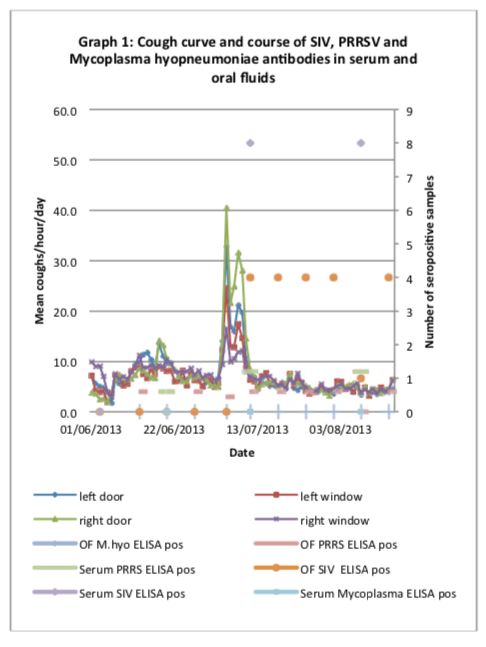Practical application of the Pig Cough Monitor in a German fattening pig herd with PRDC
Introduction
Acoustic monitoring of farm animals may serve as an efficient management tool to enhance animal health, welfare, and farm efficiency. The diagnosis of respiratory infections in pig fattening is a serious economic issue. Respiratory infections in pig fattening farms cause losses of millions of Euros per year (1). The objective of this trial was to investigate the use of a microphone-operated system (Pig Cough Monitor) to detect coughing in a fattening pig herd.
Materials and Methods
The trial was conducted in late autumn/winter 2012/2013 in a fattening herd in North-West Germany. One room with 4 pens with 25 pigs each was equipped with one microphone per pen transmitting continuous sound signals for 3.5 months to the Pig Cough Monitor, which is based on an algorithm that automatically detects and translates measured animal responses such as cough in real-time. The herd had a history of circulating PRRSV, SIV and Mycoplasma hyopneumoniae. Serum of twelve randomly selected pigs (3 per pen) was obtained once per month and analyzed for presence of antibodies against PRRSV , SIV as well Mycoplasma hyopneumoniae in order to possibly link the presence of “cough” to infection with either pathogen.
Results
The installation of the equipment requires connection to the internet, which needed some extra work to smoothly record the continuous sounds. Moreover, one microphone broke for unknown reasons end of December 2012 so that for the last 6 weeks only recordings of 3 microphones are available.
The continuous recordings of the Pig Cough Monitor are summarized in a graph by indicating the mean counts of coughs/hour/microphone (see graph 1). Although there was one microphone per pen recording coughs, it is anticipated that there is some overlap of sounds, i.e. each microphone will have recorded also some coughs from the adjacent pens.
As evident from graph 1, coughing is a regular phenomenon in pigs to clear the airway of any irritant.
In this herd an average of 10-20 coughs/hour/pen seems to be the baseline for “cough” measured by the algorithm.
Pigs seroconverted first to SIV which was accompanied by a short and transient increase in coughing. Upon seroconversion to M. hyopneumoniaethe frequency of coughing was rapidly and distinctly increased with resulting in up to 50 coughs/hour/pen. Interestingly, after the presence of antibodies against M. hyopneumoniae(Nov 30, 2012) it took 3 days until the cough frequency almost tripled. Moreover, when pigs started seroconverting against PRRSV (4.January 2013) the frequency of coughing was further increased with reaching up to 50 coughs/hour/pen.

Conclusions and Discussion
The continuous monitoring of cough by means of the Pig Cough Monitor in a German fattening herd enabled an objective measurement of “respiratory health”. In contrast to other subjective measurement (e.g. individuals counting coughs for a short period of time), this systems enables an unbiased measurement of any deviation from normal respiratory pattern and could be clearly linked to infection with both M. hyopneumoniaeand PRRSV .Based on our findings it seems that the time between seroconversion to Mycoplasma hyopneumoniae and onset of clinical relevant cough seems to short and less than previously reported.
Further research is needed on the cough pattern for each individual pathogen.
References
1. Hoy, S.: Zu den Atemwegserkrankungen auf Fruchtbarkeitsleistungen der Tierarzt 2, 121–127 (1994) Auswirkungen von die Mast- und Schweine. Prakt
